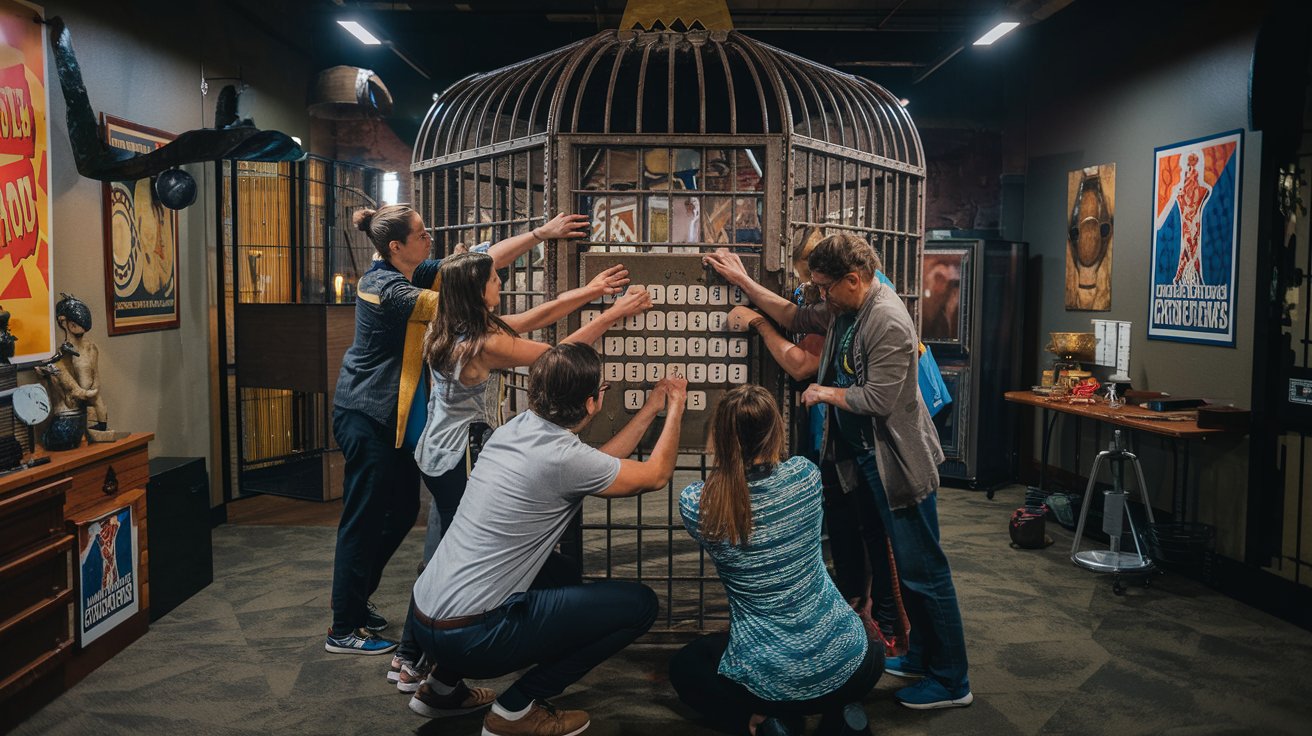Imagine this: You and your friends are locked in a mysterious room. A timer on the wall shows 60 minutes and counting down. The only way out? Solve a series of increasingly complex puzzles that will eventually lead to your freedom. Welcome to the thrilling world of escape rooms!
Escape room games have exploded in popularity over the past decade, challenging participants to use critical thinking, teamwork, and problem-solving skills to “escape” within a time limit. Whether you’re a first-timer or looking to improve your success rate, this comprehensive guide will equip you with the strategies and mindset needed to conquer any escape room challenge.
What Are Escape Room Games?
Escape rooms are immersive, interactive puzzle experiences where players are “locked” in a themed room and must solve a series of puzzles to accomplish a goal—typically escaping the room—within a set time limit (usually 60 minutes). Themes range from prison breaks and bank heists to zombie apocalypses and detective mysteries.
These physical adventure games originated from video games called “escape the room,” where players had to find hidden objects and solve puzzles to progress. The first real-life escape room was created in Japan in 2007, and the concept quickly spread worldwide. Today, there are thousands of escape rooms across the globe, each offering unique themes, storylines, and puzzle mechanics.
Why Escape Rooms Are Worth Your Time
Beyond being incredibly fun, escape rooms offer numerous benefits:
- Team Building: They foster communication and collaboration, making them perfect for corporate teams, friend groups, or family outings.
- Mental Exercise: Puzzles challenge your brain in new ways, improving problem-solving abilities and critical thinking.
- Stress Relief: The immersive experience helps you disconnect from daily stressors and focus entirely on the present challenge.
- Sense of Achievement: Successfully escaping delivers a genuine rush of accomplishment and satisfaction.
Types of Puzzles You’ll Encounter
Understanding common puzzle types helps you recognize patterns and solve challenges faster. Here are puzzles you’re likely to encounter:
1. Hidden Objects
The most basic escape room element involves finding hidden items—keys, codes, messages, or tools—essential for solving other puzzles. These might be:
- Hidden in plain sight
- Concealed in secret compartments
- Disguised as something else
- Visible only under special conditions (like UV light)
2. Pattern Recognition
These puzzles require identifying and completing patterns, which could be:
- Color sequences
- Numerical progressions
- Symbol combinations
- Spatial arrangements
3. Logic Puzzles
Logic puzzles challenge your reasoning abilities through:
- Riddles and brain teasers
- Sudoku-style grids
- Process of elimination challenges
- If-then reasoning puzzles
4. Physical Manipulation
These puzzles require dexterity and physical interaction:
- Locks and keys
- Mechanical puzzles
- Mazes and labyrinths
- Object assembly or rearrangement
5. Math and Number Puzzles
Don’t worry—these rarely require advanced mathematics:
- Simple arithmetic
- Measurement puzzles
- Counting elements
- Coordinate systems
6. Word and Language Puzzles
These test your linguistic abilities through:
- Crosswords or word searches
- Anagrams and word scrambles
- Morse code or other cipher translations
- Etymology or word origin challenges
7. Light and Sound Puzzles
These engage your senses with:
- Musical sequences
- Sound recognition
- Light patterns or color mixing
- Audio clues or instructions
Essential Tips to Successfully Escape

Before You Enter
1. Choose Your Team Wisely
The ideal team size is 4-6 people with complementary skills and thinking styles. Include:
- A detail-oriented observer
- A logical thinker
- A creative problem-solver
- Someone good with patterns
- A person skilled at physical tasks
2. Dress Appropriately
Wear comfortable clothes and closed-toe shoes. Avoid bulky accessories, high heels, or restrictive clothing that might limit movement.
3. Arrive Early
Get to the venue 15-20 minutes before your scheduled time. This allows for checking in, using restrooms, and mentally preparing without feeling rushed.
4. Listen Carefully to Instructions
Pay close attention to the game master’s briefing. They often drop subtle hints about what’s important or provide context that could help you later.
When the Clock Starts
1. Search Thoroughly
The first 5-10 minutes should be dedicated to methodical searching:
- Check every drawer, shelf, and container
- Look under furniture and rugs
- Examine walls and ceilings
- Feel for hidden compartments
Pro tip: When you find an object, announce it to the team and place all discovered items in a central location.
2. Organize Your Findings
Create a system for tracking:
- Puzzles that have been solved
- Puzzles still in progress
- Items that haven’t been used yet
- Locks that need combinations or keys
3. Communicate Effectively
Clear communication is crucial:
- Verbalize what you’re working on
- Share discoveries immediately
- Describe puzzles clearly if asking for help
- Listen to others’ ideas without dismissing them
4. Recognize Patterns and Connections
Look for relationships between objects and puzzles:
- Similar colors or symbols
- Matching numbers or sequences
- Thematic connections
- Items that physically fit together
5. Divide and Conquer (But Stay Connected)
Split into smaller groups to tackle different puzzles simultaneously, but:
- Periodically share progress
- Rotate if someone is stuck
- Combine forces for complex puzzles
- Be ready to help others when needed
Advanced Strategies for Escape Room Success
1. Manage Your Time Wisely
The clock is your biggest opponent:
- Set mental checkpoints (e.g., “We should be halfway through by 30 minutes”)
- If stuck on a puzzle for more than 5-7 minutes, move to another and return later
- Save 5-10 minutes at the end for any remaining puzzles
- Designate someone as the timekeeper
2. Use Hints Strategically
Don’t view hints as failures—they’re tools provided by the game designers:
- Request hints for puzzles where you’ve made no progress after several attempts
- Ask for hints with about 15-20 minutes remaining if you’re significantly behind
- Be specific when requesting hints so the game master can provide relevant guidance
3. Think Outside the Box
Escape rooms reward creative thinking:
- Question your assumptions
- Try unconventional approaches
- Look for multiple uses of the same item
- Consider how the room’s theme might influence puzzle solutions
4. Remember: Not Everything Is a Puzzle
New players often make the mistake of overthinking:
- Some decorations are just decorations
- Not every number is part of a combination
- Room fixtures (like air vents or sprinklers) are rarely part of the game
- Focus on elements that seem deliberately placed or highlighted
Common Puzzle-Solving Techniques
For Combination Locks
- Try obvious combinations first: Birth years, calendar dates, or numbers prominently displayed in the room.
- Check for directional instructions: Some locks require turning right-left-right.
- Listen for clicks: Each correct number often produces a small click.
- Reset completely: If unsuccessful, return to zero and try again.
For Hidden Messages
- Use UV lights on walls, objects, and papers (if provided).
- Hold papers against light sources to reveal watermarks.
- Feel for indentations on surfaces that might indicate a message.
- Check reflections in mirrors or shiny surfaces.
For Cipher Puzzles
- Look for keys or legends in the room that might explain the cipher.
- Start with common substitution ciphers: A=1, B=2, etc.
- Consider the theme of the room for contextual clues.
- Try reversing the message or reading it backward.
What Not to Do in an Escape Room
Avoid these common mistakes:
- Don’t force anything: If something requires excessive physical effort, you’re probably approaching it wrong.
- Don’t separate or hide pieces: Keep everything visible to the team.
- Don’t ignore teammates: Listen to all ideas, even if they seem unlikely.
- Don’t fixate on one puzzle: If stuck, move on and return later.
- Don’t forget the objective: Sometimes players get so caught up in individual puzzles they lose sight of the overall goal.
How to Improve Your Escape Room Skills
Like any skill, escape room mastery improves with practice:
- Play brain-training games: Puzzles, riddles, and logic games keep your mind sharp.
- Try online escape games: Virtual escape rooms provide low-pressure practice.
- Solve physical puzzle boxes: These develop the thinking patterns useful in escape rooms.
- Read mystery novels: They train you to spot clues and make connections.
- Analyze past performances: After each escape room, discuss what worked and what didn’t.
Special Considerations for Different Escape Room Types
Horror-Themed Rooms
These create tension through atmospheric elements:
- Focus on puzzles rather than scare factors
- Designate a team member who’s comfortable taking the lead in frightening scenarios
- Remember that jump scares are designed to distract—stay focused
Family-Friendly Rooms
When playing with younger participants:
- Assign age-appropriate tasks to everyone
- Guide children rather than solving for them
- Celebrate small victories to maintain enthusiasm
- Be patient and make the experience fun regardless of outcome
Competitive Multi-Room Challenges
When racing against other teams:
- Prioritize efficiency over thoroughness
- Communicate in hushed tones to prevent other teams from overhearing
- Develop quick signals for common situations
- Stick to your strengths rather than trying new approaches
Conclusion: The Psychology of Success
The most successful escape room teams share certain psychological traits:
- Resilience: They don’t get discouraged by setbacks
- Flexibility: They adapt quickly when approaches aren’t working
- Positivity: They maintain an energetic, can-do attitude
- Presence: They stay focused in the moment rather than worrying about the clock
Remember that escape rooms are designed to be completed—with the right approach, communication, and teamwork, you can dramatically increase your chances of breaking free before time runs out.
Whether you’re looking for a fun night out, team-building activity, or mental challenge, escape rooms offer a unique, immersive experience that tests and strengthens your problem-solving abilities. The skills you develop—observation, logical thinking, communication, and grace under pressure—extend far beyond the game room and into real life.
So gather your team, set your mind to puzzle-solving mode, and get ready for an adventure that will challenge, entertain, and maybe even transform how you approach problems. The clock is ticking—will you escape in time?

Zareb Saleh is a journalist at Gulf Today and a ghostwriter for Gameoholic, specializing in gaming, technology, and digital culture. With a keen eye for industry trends, he delivers insightful stories that engage and inform readers.




